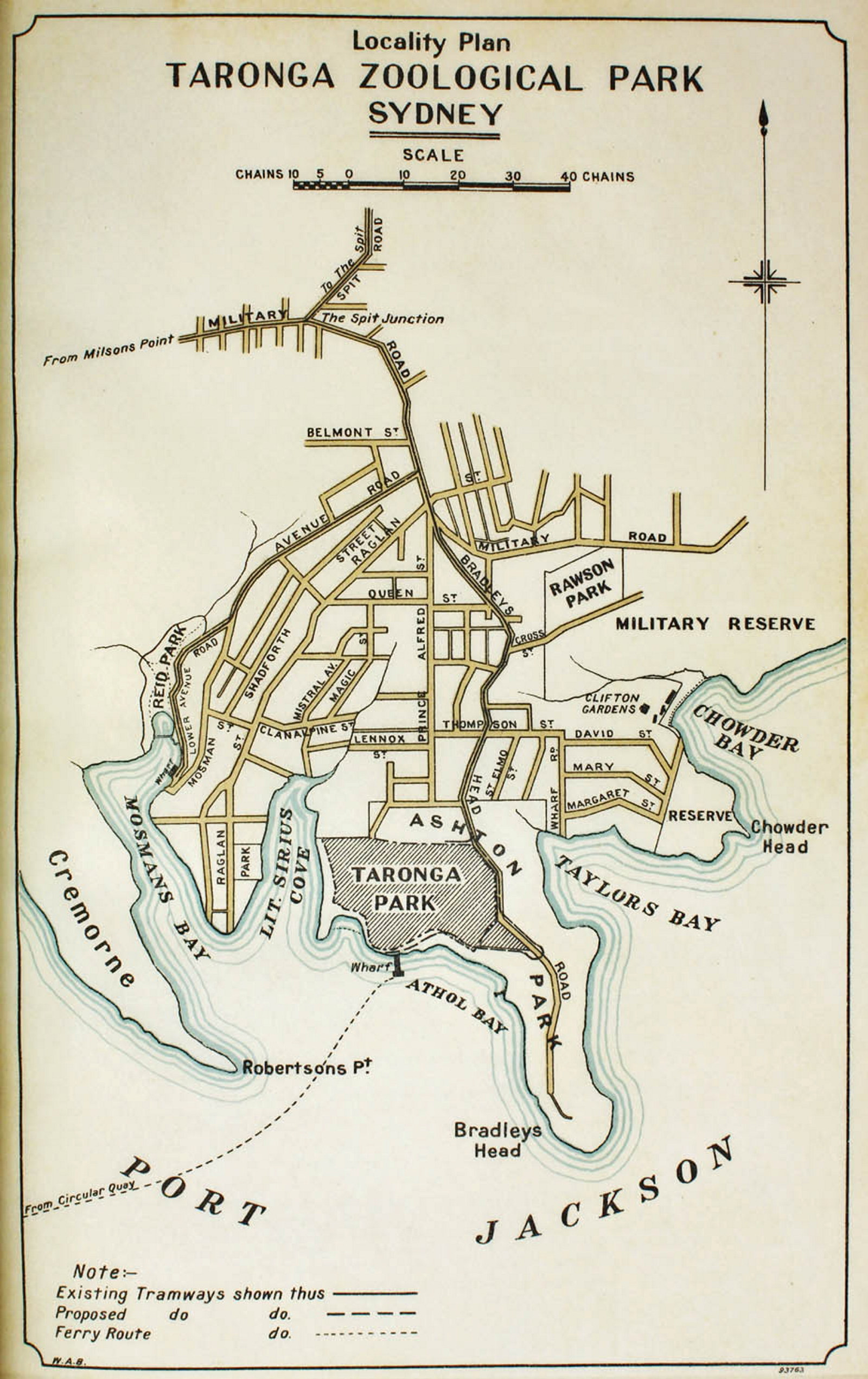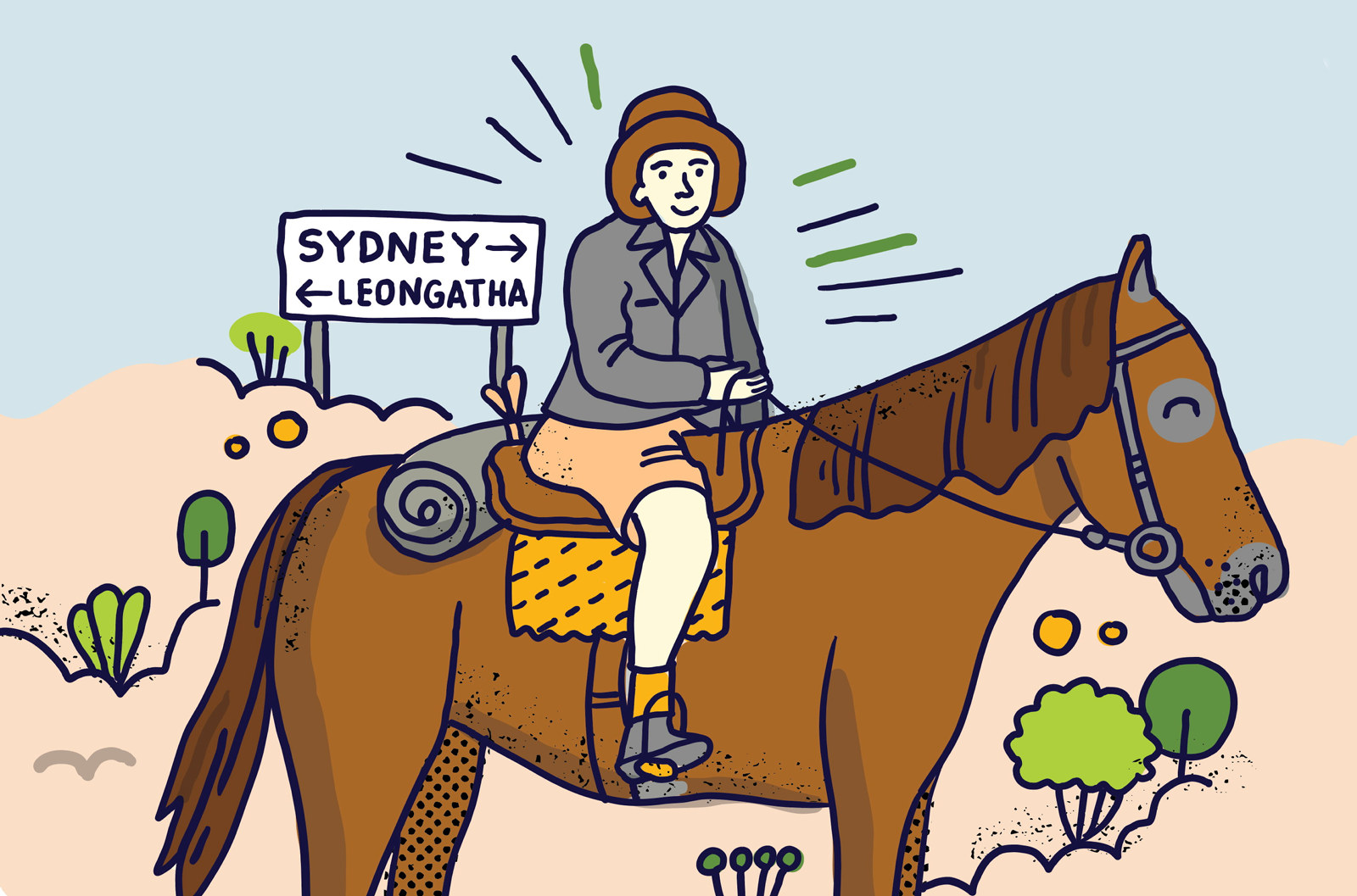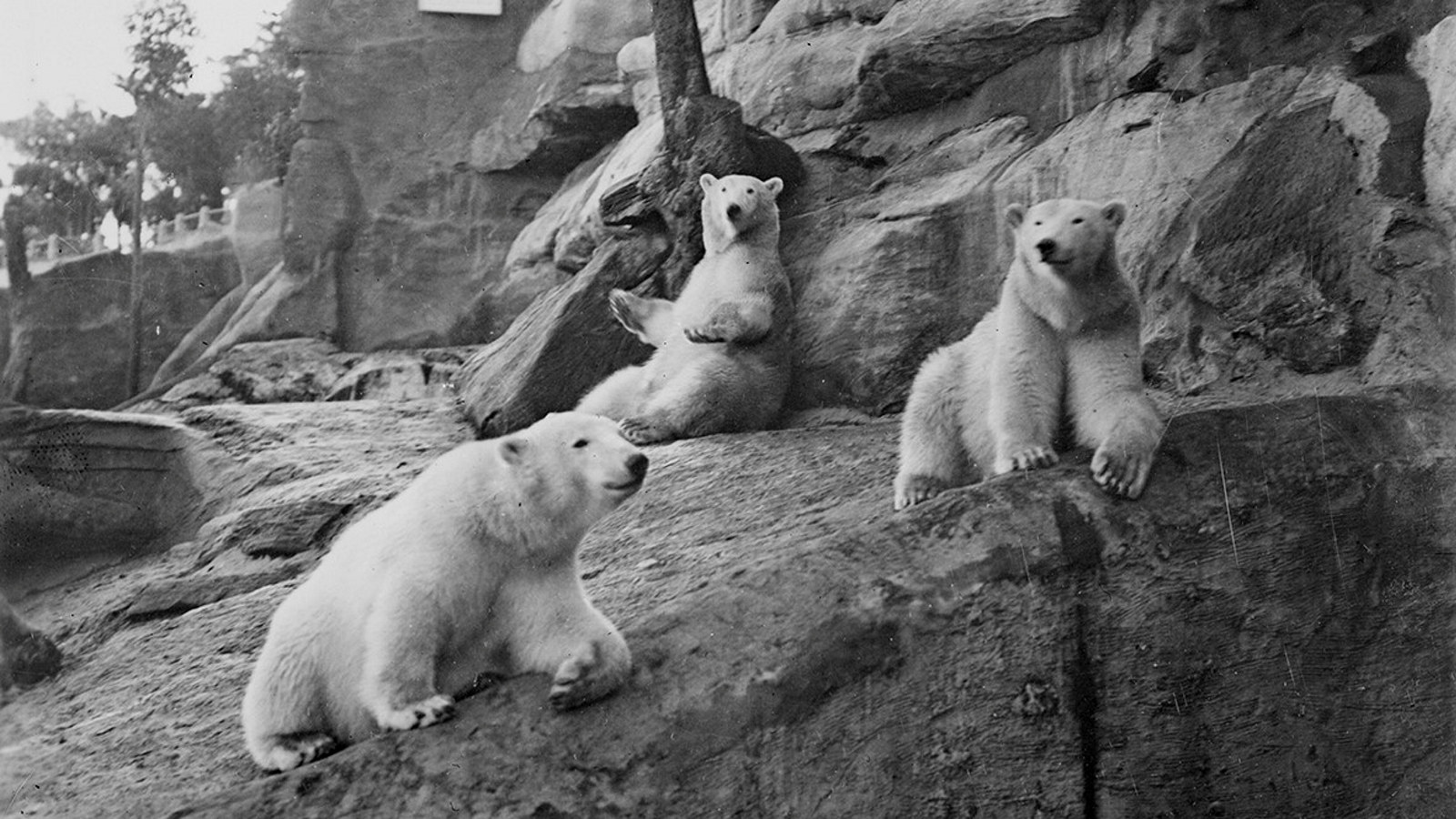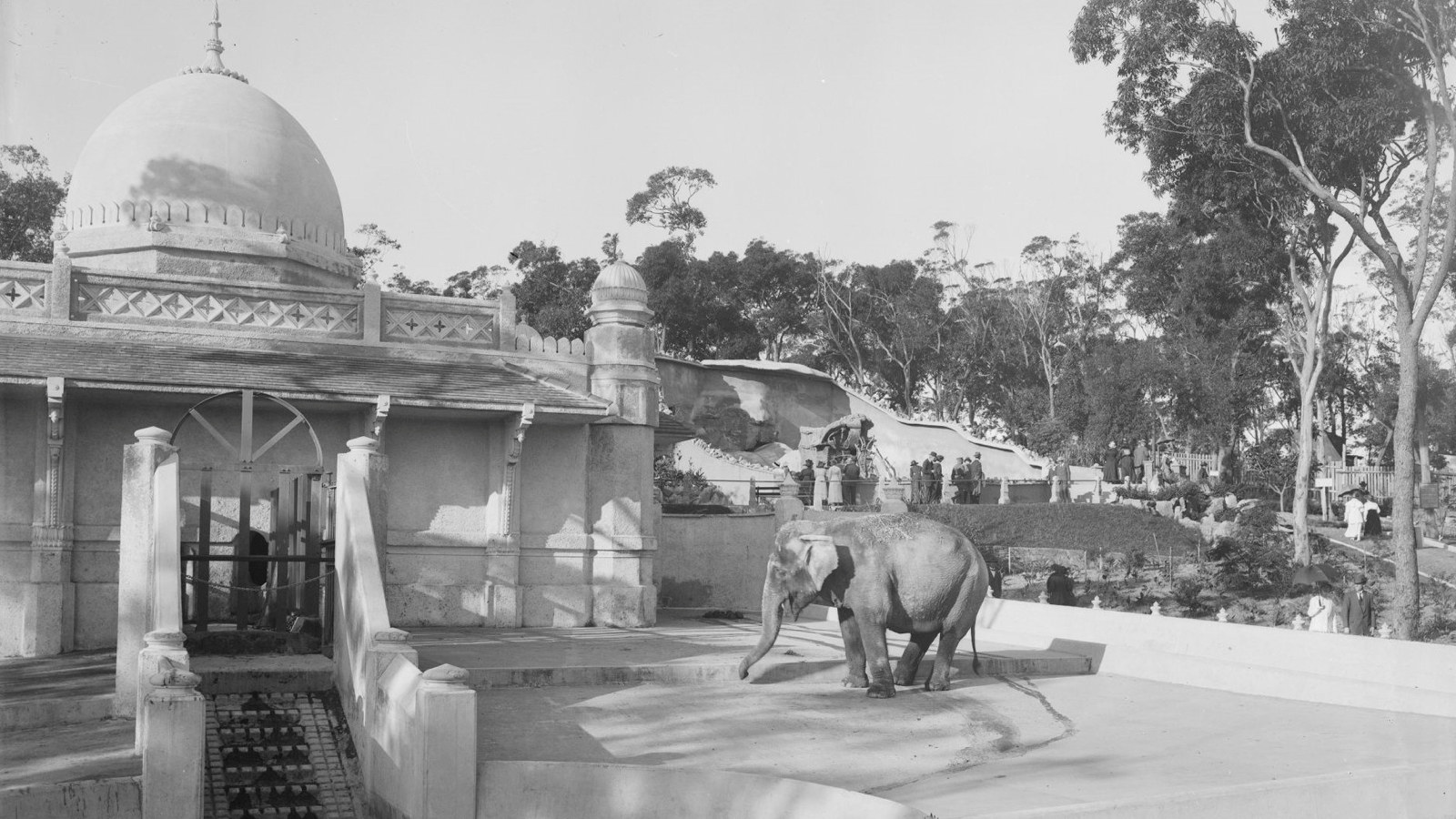History of Taronga Zoo
A brief history and examples of records from the State Archives Collection relating to Taronga Zoo.
Taronga Zoo opens to the public
Can you imagine Sydney Harbour without Taronga Zoo perched on Bradley’s Head at Mosman? For one hundred years families have been making the trip by ferry, tram and car to see the exotic and native animals at Taronga and get a picturesque view of the harbour.
After keeping some of the animals at the Botanic Gardens for a number of years (above), Sydney’s first public zoo was opened in 1883 on seven acres located at Billy Goat Swamp in Moore Park (on the site now occupied by Sydney Girls’ High School).[1] The zoo was run by the Society for Acclimatisation. Although the zoo was enlarged to 12.5 and then 15 acres, by 1905 it became clear that the location was not ideal or large enough.[2] Albert Le Souef, secretary for the Society, went overseas to look at European and American zoos and returned to Sydney in 1908 with a vision for a bar-less zoo.[3]
In 1909 a Royal Charter was granted and the name of the Society changed to The Zoological Society of NSW. An appeal was made to the Government for a new site for the zoo and in 1911 Ashton Park, near Bradley’s Head, was chosen and dedicated for the use of the new zoo.[4] The Zoological Society was replaced by the Taronga Zoological Park Trust, formed under the Public Parks Act 1902, to operate the zoo.[5] Initially the site granted to the Trust was 43 acres but that was enlarged to 60 acres by 1916. George McRae, the Government Architect, designed the top entrance, lower entrance and the Indian elephant house exhibit.[6] The name Taronga, Aboriginal for ‘sea-view’, was chosen to reflect the view from the new location.[7]
A new site
Work began on the Ashton Park site with private contractors in August 1912 and the main roadways were laid out.[8] The seal ponds, monkey pits, aviaries and elephant temple were among the first exhibits to be built.[9] The Public Works Department took over construction in 1915 and completed the zoo. Infrastructure such as pathways, gardens, tea rooms and the iconic main entrance gates were finished. By June 1917, Public Works had spent £74,573 on construction on the zoo site and extending the North Shore tramway to connect with the wharf at the lower entrance.[10]
Looking at the Treasury Department’s Letters received registers (NRS 14125) evidence can also be found of how much extra money the new zoo required in the tight war-time economy. In a letter dated 17 March 1915 the Zoo Trust requested £1000 per month to maintain the two zoo sites while Taronga was under construction.[11] Later in the year an additional £500 per month was granted for Taronga Park.[12]
During 1916 extra money was also required for the purchase of additional animals for the new zoo. By 1 September 1916 228 mammals, 552 birds and 64 reptiles had been rehoused at Taronga from Moore Park.[13] In February 1915 the Society asked for a £500 special grant to purchase a bulk lot of African animals, including baboons, tortoises, antelope and springbok.[14] Later in the year another grant of £200 was used to buy an elephant.[15] During 1916 the Society spent £1400 on purchasing new animals.[16]

The opening
From 11 September 1916 the first wave of publicity for the new zoo started with public school children in metropolitan Sydney visiting the park for free.[17] The Government subsidised special trams and ferries for the children to travel to the zoo. School Parents & Citizens’ organisations were encouraged to provide picnics for the outing. Over 120,000 school kids visited the zoo in the month before it officially opened, which works out at an average of 3000 children per day.[18]
On the afternoon of Saturday 7 October 1916 Taronga Zoological Park was officially opened. The ceremony and speeches took place at the main entrance building, where some 2000 people gathered to see Premier Holman open the Park. Sydney-siders had taken advantage of the special trains that operated for the opening and flocked to the Zoo.[19] Only part of the new grounds were complete with the remainder of the site scheduled to be finished by Christmas.[20] Refreshments were provided and bands played throughout the grounds as the general public took their first look at Taronga.
The new zoo proved to be a popular destination for Sydney families almost immediately. From 7 October to 31 December 1916 the Park took in £3519 and elephant rides alone raised £65.[21] Early entrance prices were 6 pence for adults and 3 pence for children. For 100 years, Taronga Zoo has continued to be a popular destination for locals and tourist alike.
Footnotes
[1] Evening News, 27/7/1883, p. 1, ‘Zoological Society, Moore Park’; “Report of the Taronga Zoological Park Trust, Sydney”, Parliamentary Papers, 1917-18, Vol. 4, p. 1.
[2] Ibid., p. 19.
[3] Ibid.
[4] Ibid.
[5] Ibid.
[6] “Taronga Zoo – Upper & Lower Entrance Gates, Elephant House, Aviary, Floral Clock” , Office of Environment and Heritage, accessed on 20 June 2016.
[7] “Report of the Taronga Zoological Park Trust”, Parliamentary Papers, 1917-18, Vol. 4, p. 20
[8] “Taronga Zoo – Upper & Lower Entrance Gates, Elephant House, Aviary, Floral Clock” , Office of Environment and Heritage, accessed on 20 June 2016.
[9] Ibid, “Taronga Zoo History”, taronga.org.au, accessed 20 June 2016.
[10] “Report of the Department of Public Works for the Year Ended 30 June 1917, Parliamentary Papers, 1917-18, Vol. 4, p.899
[11] NRS 14125, [9/1503], A15/2192
[12] NRS 14125, [9/1504], A15/6690, A15/7414, A15/8559
[13] “Report of the Taronga Zoological Park Trust”, Parliamentary Papers, 1917-18, Vol. 4, p.20 and “Taronga Zoo History”.
[14] NRS 905, [5/7481], 16/58049
[15] NRS 14125, [9/1506], A16/7772
[16] NRS 14139, [10/21613], A16/8325
[17] “Report of the Taronga Zoological Park Trust”, Parliamentary Papers, 1917-18, Vol. 4, p. p.20
[18] Ibid.
[19] NRS 14125 [9/1506] A16/8325
[20] “The New Zoo: Official Opening”, Sydney Morning Herald, 9 October 1916, p.6
[21] “Report of the Taronga Zoological Park Trust”, Parliamentary Papers, 1917-18, Vol. 4, p.25
Published on

Lennie Gwyther
Lennie ‘the Legend’ Gwyther spent his childhood running around the foothills of Leongatha in country Victoria with his four younger siblings and his prize-winning pony, Ginger Mick

Zoo Stories
Discover the incredible true story behind the Museum of Sydney's exhibition How to Move a Zoo

The story of how to move a zoo
In the early hours of Sunday, 24 September 1916, an elephant named Jessie walked out through the gates of the Zoological Gardens at Moore Park in Sydney’s eastern suburbs and began an extraordinary journey through the city

Jessie the elephant
More than any other zoo animal, Jessie the elephant captured the hearts of Sydneysiders, delighting visitors at Moore Park Zoo and then Taronga for more than 50 years